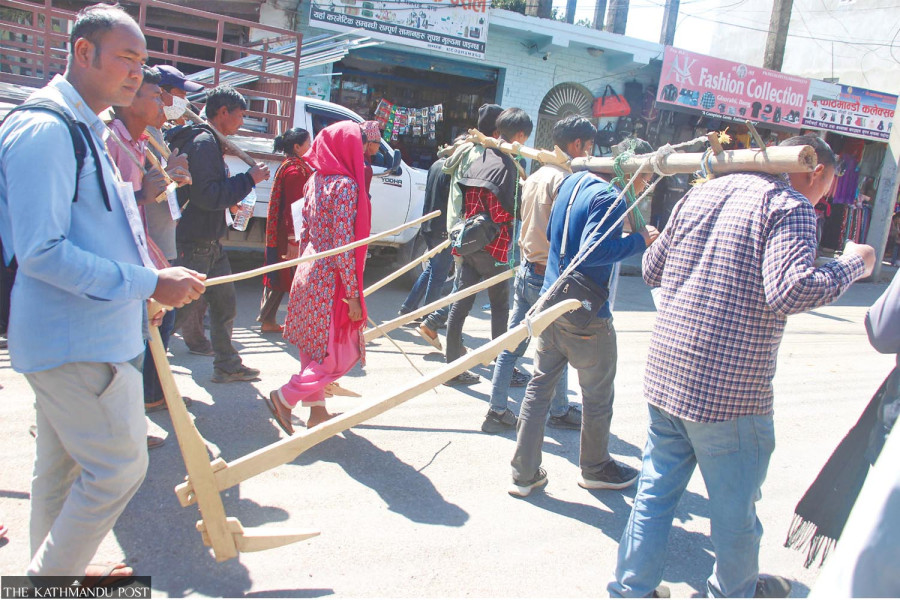Lumbini Province
Swargadwari Trust’s tenant farmers stage protest demanding land ownership
The trust owned 1,354 hectares of land in Pyuthan, Dang and Rolpa districts, but this has dwindled to 711 hectares.
Durgalal KC
As a symbolic protest, farmers in Ghorahi of Dang district were harnessed to ploughs and paraded along the street in a bid to pressure the government into resolving their long standing issue of land ownership.
Hundreds of agitating farmers took to the street with ploughs, yokes, spades and other agricultural implements in Ghorahi, the district headquarters of Dang district, in Lumbini Province, on Thursday. They staged their protest march near the district administration office and went around the town before converging into a corner meeting at Bhanu Chowk.
“We have been protesting for the past nine days. But the government did not heed our demands. We took to the streets parading like animals because the government has treated us in the same manner,” said Jayandra Chaudhary, a tenant farmer of the Swargadwari Ashram Trust. “We tilled the land for years. We just have documents to recognise us as tenant farmers but we don’t get land.”
Hundreds of farmers, who have been tilling the land belonging to the Swargadwari Ashram Guthi (trust) for generations, have launched a protest since February 20 demanding ownership of the land. The series of protests have been launched under the banner of “Swargadwari Guthi Tenants Farmers Struggle Committee”.
Swargadwari Ashram, a revered shrine in Pyuthan district established in 1941, owns a total of 1,034 bigha and 17 kattha (over 700 hectares) land in Dang. Tenant farmers have been tilling a total of 753 bigha (510 hectares) of the Guthi land for generations.
The main source of income for the Swargadwari Ashram comes from the land, in the form of fees paid by tenants either in cash or crops.
Many major temples in Nepal have been sustaining themselves for the past hundreds of years through the income generated from lands donated by individuals in the past, which funds the temples’ operations, daily worship, and traditions.
According to Prabhu Chaudhary, there were a total of 289 households of tenant farmers in the beginning, but now that has reached over 3,500 households. “This accounts for around 15,000 members, all of whom depend on the tenant farming,” he added.
The tenant farmers rue that the government authorities are indifferent to their problems. “The authorities concerned promised to address our issue time and again, but our situation remained the same. We have been tilling the land for generations but we are deprived of land ownership certificates,” complained Sabitri Chaudhary, another protesting tenant farmer.
The agitating farmers including senior citizens, children and women have been continuously protesting in the streets since February 20. “Many farmers have taken ill. Senior citizens and children are the hardest hit. The government is not sincere about our demand. The farmers are saddened due to the government’s apathy,” said Bharat Raj Giri, secretary of the struggle committee.
Owing to legal complications, the Guthi lands belonging to the Swargadwari Ashram have dual ownership. On the one hand, the Supreme Court in 2006 had issued a mandamus order stating that the land of Swargadwari Ashram could not be fragmented as Swargadwari Guthi is the private Guthi with specific characteristics. On the other hand, hundreds of tenant farmers have been demanding ownership of the lands that they have been tilling for years.
The agitating farmers demand the ratification of a Guthi bill, which was withdrawn from the National Assembly in 2019. The struggle committee urges the government to establish the rights of the tenant farmers and ratify the bill accordingly.
On December 31, 2023 Swargadwari Ashram Management Committee formed a panel to study the dual ownership of its land. The nine-member panel led by Basudev Bhattarai has been given six months to study the issue and submit a report.
In the past, the Swargadwari Ashram owned nearly 2,000 bigha (1354 hectares) of land in Pyuthan, Dang and Rolpa districts. The land has now dwindled to around 1,050 bigha now. People have been using 753 bigha of the ashram land.




 16.12°C Kathmandu
16.12°C Kathmandu












